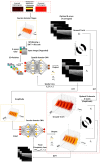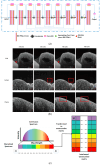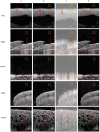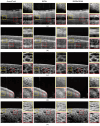Reconstruction of Optical Coherence Tomography Images from Wavelength Space Using Deep Learning
- PMID: 39796883
- PMCID: PMC11723098
- DOI: 10.3390/s25010093
Reconstruction of Optical Coherence Tomography Images from Wavelength Space Using Deep Learning
Abstract
Conventional Fourier domain Optical Coherence Tomography (FD-OCT) systems depend on resampling into a wavenumber (k) domain to extract the depth profile. This either necessitates additional hardware resources or amplifies the existing computational complexity. Moreover, the OCT images also suffer from speckle noise, due to systemic reliance on low-coherence interferometry. We propose a streamlined and computationally efficient approach based on Deep Learning (DL) which enables reconstructing speckle-reduced OCT images directly from the wavelength (λ) domain. For reconstruction, two encoder-decoder styled networks, namely Spatial Domain Convolution Neural Network (SD-CNN) and Fourier Domain CNN (FD-CNN), are used sequentially. The SD-CNN exploits the highly degraded images obtained by Fourier transforming the (λ) domain fringes to reconstruct the deteriorated morphological structures along with suppression of unwanted noise. The FD-CNN leverages this output to enhance the image quality further by optimization in the Fourier domain (FD). We quantitatively and visually demonstrate the efficacy of the method in obtaining high-quality OCT images. Furthermore, we illustrate the computational complexity reduction by harnessing the power of DL models. We believe that this work lays the framework for further innovations in the realm of OCT image reconstruction.
Keywords: image reconstruction; optical coherence tomography; speckle noise; time complexity.
Conflict of interest statement
The authors declare no conflicts of interest.
Figures







Similar articles
-
Noise-imitation learning: unpaired speckle noise reduction for optical coherence tomography.Phys Med Biol. 2024 Sep 3;69(18). doi: 10.1088/1361-6560/ad708c. Phys Med Biol. 2024. PMID: 39151463
-
Deep learning-based image enhancement in optical coherence tomography by exploiting interference fringe.Commun Biol. 2023 Apr 28;6(1):464. doi: 10.1038/s42003-023-04846-7. Commun Biol. 2023. PMID: 37117279 Free PMC article.
-
Physics-guided deep learning-based real-time image reconstruction of Fourier-domain optical coherence tomography.Biomed Opt Express. 2024 Oct 30;15(11):6619-6637. doi: 10.1364/BOE.538756. eCollection 2024 Nov 1. Biomed Opt Express. 2024. PMID: 39553872 Free PMC article.
-
Lateral image reconstruction of optical coherence tomography using one-dimensional deep deconvolution network.Lasers Surg Med. 2022 Aug;54(6):895-906. doi: 10.1002/lsm.23543. Epub 2022 Apr 2. Lasers Surg Med. 2022. PMID: 35366377
-
Unraveling the complexity of Optical Coherence Tomography image segmentation using machine and deep learning techniques: A review.Comput Med Imaging Graph. 2023 Sep;108:102269. doi: 10.1016/j.compmedimag.2023.102269. Epub 2023 Jul 14. Comput Med Imaging Graph. 2023. PMID: 37487362 Review.
References
-
- Bakator M., Radosav D. Deep learning and medical diagnosis: A review of literature. Multimodal Technol. Interact. 2018;2:47. doi: 10.3390/mti2030047. - DOI
Grants and funding
LinkOut - more resources
Full Text Sources

